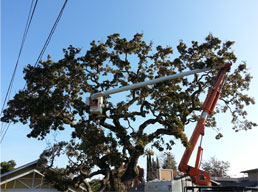|
| |
|
| Pruning |
|
| An arborist can determine the type of pruning necessary to maintain or improve the health, appearance, and safety of trees. These techniques include |
|
- eliminating branches that rub each other
- removing limbs that interfere with wires, building facades, gutters, roofs, chimneys, or windows, or that obstruct streets or sidewalks
- removing dead or weak limbs that pose hazard or may lead to day
- removing diseased or insect-infested limbs
- creating better structure to lessen wind resistance and reduce the potential for storm damage
- training young trees
- removing limbs damaged by adverse weather conditions
- removing branches, ore thinning, to increas light penetration
- improving the shape or silhouette of the tree
|
|
| |
|
| Types of Pruning |
|
| Crown Cleaning |
|
| Crown cleaning or cleaning out is the removal of dead, dying, diseased, crowded, weakly attached, and low-vigor branches and waterspouts from a tree crown. |
|
| |
|
|


|
|
| Crown Thinning |
|
Crown thinning includes crown cleaning and the selective removal of branches to increase light penetration and air movement to the crown. Increased light and air stimulates and maintains interior foliage, which in turn impoves branch taper and strength. Thinning reduces the wind-sail effect of the crown and the weight of heavy limbs. Thinning the crown can emphasize the structural beauty of trunk and branches as well as improve the growth of plants beneath the tree by increasing light penetration. When thinning the crown of mature trees, seldom should more than one-third of the live foliage be removed.
At least one-half of the foliage should be on branches that arise in the l lower two-thirds of the trees. Likewise, when thinning laterals from a limb, an effort should be made to retain inner lateral branches and leave the same distribution of foliage alon the branch. Trees and brancesh so pruned will have stress more evenly distributed throughout the tree or along a branch.
|
|
| |
|
| Crown Reduction |
|
| Crown reduction is used to reduce the height and/or spread of a tree. Thinning cuts are most effective in maintaining the structural integrity and natural form of a tree and in delaying the time when it will need to be pruned again. The lateral to which a branch or trunk is cut should be at least one-half the diameter of the cut being made. |
|
| |
|
| Crown Restoration |
|
| Crown restoration can improve the structure and appearance of trees that have been topped or severely pruned using heading cuts. One to three sprouts on main branch stubs should be selected to reform a more natural appearing crown. Selected vigorous sprouts may need to be thinned to a lateral, even headed, to control length growth in order to ensure adequate attachment for the size of the sprout. Restoration may require servaral prunings over a number of years. |
|
| |
|
| |
|
| |
|
If your considering removing your tree and need our advice please give us a call at (650) 996-0360
We proudly service Tree Removal Services in Redwood City, Atherton, San Carlos, Belmont, Peninsula and also provide other Bay Area Tree Removal locations. |
|
| |
|
|
|
|
|